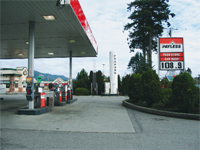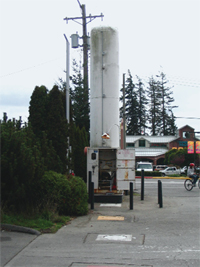
Features
Hot topics
Incident reports
Flammable gas: Propane leak, vapour cloud force evacuation in B.C. community
It was one of those typical, damp, west-coast fall evenings that was interrupted when the Sooke Fire Department in B.C. was toned out for a propane leak at a Payless gas station.
March 18, 2008
By Steve Sorensen
 |
| Firefighters in Sooke, B.C., prevented what could have been a major incident after a propane tank valve was accidentally left open at a gas station. PHOTOS COURTESY STEVE SORENSEN
|
It was one of those typical, damp, west-coast fall evenings that was interrupted when the Sooke Fire Department in B.C. was toned out for a propane leak at a Payless gas station.
This service station is in the centre of the business district on busy Highway 14.
With a crew already in Station One for a training session, the response time to the Oct. 14, 2005, incident was less than five minutes.
First arriving Engine 205, a 1250/1000 pumper, along with the fire chief and duty officer were met with a large gas cloud emanating from a 2,000-gallon vertical propane-storage tank.
The vapour cloud was about 7.5 metres high and was starting to drift across Highway 14, directly into the parking lot of a large shopping mall.
RCMP quickly set up a road block at either end of the town centre to divert traffic away from the scene.
While the engine crew hooked up to a nearby hydrant and began to deploy hose lines, the chief quickly began evacuating shoppers from the mall.
By now, the vapour cloud had crossed the highway and began enveloping the vehicles in the mall parking lot.
Several shoppers had to be convinced not to get into their vehicles and drive away, but to quickly vacate the area on foot. (One woman managed to drive around the police roadblock, then stopped in the vapour cloud to ask firefighters what was going on.)
With the cloud rapidly growing, additional fire apparatus and personnel began arriving on scene.
Engine 201, another 1250/1000 pumper, pulled into another mall parking lot adjacent to the leaking tank.
Taking the hydrant in the parking lot, the crew deployed its 1,000-gpm deck gun and an additional 2.5-inch line on the gas cloud.
 Additional firefighters assisted the first-in engine by deploying more lines in and around the escalating incident.
Additional firefighters assisted the first-in engine by deploying more lines in and around the escalating incident.
At this stage, the gas cloud had completely covered the highway, the mall parking lot across the highway and was entering the stores located at the south end of the mall. This included a McDonalds restaurant where staff luckily remembered to shut off the cooking appliances before evacuating the area.
With one master stream, one 2.5-inch hose line and four 1.75-inch hose lines, firefighters were desperately struggling to keep the vapour cloud down on the ground as much as possible.
After a quick conference between the chief and senior firefighters, it was decided that one attempt would be made to locate and secure the source of the leak.
If this failed, crews would set up unmanned master-stream devices and evacuate the area.
In full protective gear and under the protection of several hose streams, two firefighters entered the cloud to locate the source of the leak.
As they neared the tank, they could hear that the discharge pump used for the retail sale of propane was operating.
With zero visibility, the two firefighters began feeling their way around the tank controls for the disconnect switch. It was quickly located and the power to the pump was shut off.
The flow of propane immediately slowed and then stopped. With all the water sprayed on the scene, crews were now faced with a large block of ice containing frozen propane in the control cabinet.
Over the next 90 minutes, the ice block began to shrink, releasing propane vapours as it melted.
With the cloud now dissipating, fire crews began taking gas readings in all of the manholes and shops within the hazard area.
| What is propane
According to the Propane Gas Association of Canada: • Propane Is a three-carbon alkane – its molecular formula is C3H8.
|
Areas showing strong readings were ventilated and people were allowed back into the area about 2.5 hours after the incident began.
It was later determined that about 530 litres of liquid propane had leaked from the tank. At an expansion ratio of 270 to one from liquid to vapour, the resulting cloud grew and spread very rapidly.
Cause of the leak was found to be a discharge valve in the control cabinet, left open by an employee who had earlier filled a propane barbeque tank.
After filling the tank, the employee shut off the power to the pump but left the discharge valve open.
When a vehicle later came in to fuel up at the auto propane fuel pump, propane began leaking from this open valve as soon as the pump was turned on.
Because the bottle-fill station and the auto-fuel pump shared the same pumping system, propane began flowing once the power was turned on. With the valve left open, propane immediately began leaking at the control cabinet.
Spotting the vapour discharging from the cabinet area, the attendant quickly shut off the auto pump and ran over to the tank.
As residual propane was still leaking out the open hose, and thinking the power was still on to the pump, she turned the power switch. As it was already off, this actually turned it back on and the leak started all over again.
The emergency shut-off device was then activated but this did not work and propane continued to flow.
Thinking something was broken at the tank or control valves, she quickly ran back into the station office and hit the emergency shut-off switch.
After investigation, it was determined that this switch only worked on the gasoline and diesel pumps.
Lessons learned
The auto propane pump that was installed several years after the service station had been opened was not connected to the emergency system. It was also found that the emergency switch at the propane tank did not function due to the leaking propane. As this switch works on a spring and cable system, the resulting leak of liquid propane had frozen all of the controls into the open position and could not operate until the propane ice block melted. These deficiencies have since been corrected.
At the District of Sooke’s annual firefighter appreciation banquet later that year, Mayor Janet Evans presented all 18 attending firefighters and two RCMP officers with a certificate of valour for their heroic action in preventing what could have been a major disaster for the community.
Steven Sorensen is deputy chief of the Sooke Fire Department. He can be reached at ssorensen@sooke.ca
Print this page
Advertisement
- Incident Report: Fire too advanced for interior attack
- Trainer’s Corner: Hydro guide for first responders